Crassula sladenii
Crassula sladenii Schönland
Family: Crassulaceae
Common names: Hunsberg cliff-crassula (Eng.), Hunsberg-sosatie (Afr.)
Introduction
Crassula sladenii is a rare, sparingly branched, scrambling succulent shrublet, becoming a cliff-hanger with stems up to 400 mm long. The leaves are greyish-green, fused and disk-like. The inflorescence is a short, rounded thyrse of small, star-shaped, whitish flowers, in autumn. Plants are only known from the Hunsberg in southern Namibia and the Richtersveld, growing on dolomite cliffs.
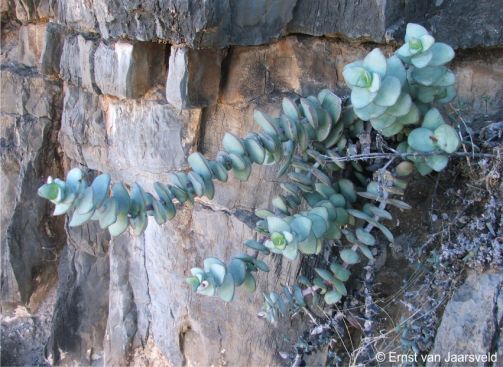
Fig. 1. Crassula sladenii growing on a dolomite cliff on the Hunsberg, southern Namibia.
Description
Description
The plants are spreading, somewhat scrambling, sparsely branched, with stems up to 400 mm long. The roots are fibrous. The branches are grey-brown, 4 mm in diameter succulent at first, becoming woody. The leaves are egg-shaped to ovate-lanceolate, 25–40 × 15–25 mm, flattened. The opposite leaf pairs are basally fused and the leaf surface is without hairs (glabrous) and grey-green or pale green, with a powdery bloom, the upper surface flat and the lower surface convex, and the margin is reddish. The leaf tips are blunt (obtuse) or pointed. The older leaves are persistent. The inflorescence consists of an elongated, round-topped thyrse bearing a short peduncle up to 20 mm long, with sessile flowers. The calyx lobes are triangular-lanceolate, up to 2 mm long, acute. The corolla is tubular, white, shortly fused at the base; the lobes oblong-elliptic, up to 5 mm long. It has black anthers. Plants flower in autumn (March to May).
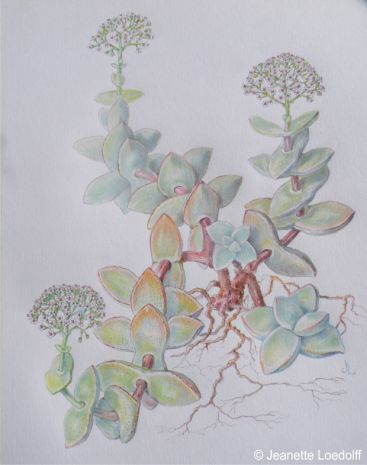
Fig. 2. Illustration of Crassula sladenii by Jeanette Loedolff, from plants growing on the Hunsberg, southern Namibia.
Conservation Status
Status
Crassula sladenii is a Rare species, assessed as Near Threatened (NT) by the Red List of South African Plants in 2009 and upgraded to Endangered (EN) in 2015. Although locally abundant and well protected in its cliff habitat, field monitoring indicated that the population was declining in as many as 80% of subpopulations that were healthy and abundant just 10 years previously. The reasons are not clear. There is ongoing habitat loss caused by mining activities in parts of its habitat where sand blown from exposed mine dumps is burying low-growing plants. Also, severe overgrazing and trampling is affecting the larger shrubs, which in turn is exposing Crassula sladenii plants to direct sun and hotter temperatures, and plants are dying as a result. Disease and climate change could also be factors.
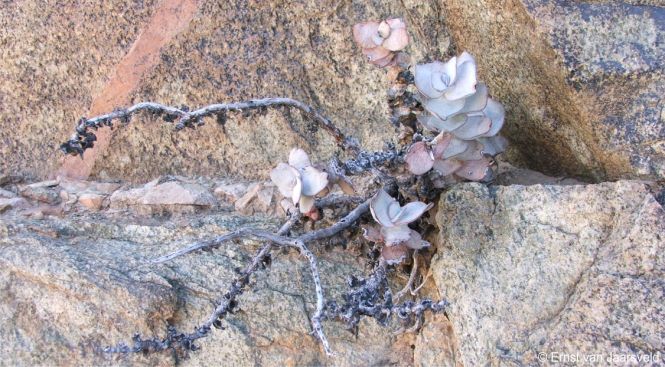
Fig. 3. A struggling plant of Crassula sladenii barely surviving due to regular droughts, Hunsberg, southern Namibia.
Distribution and habitat
Distribution description
Crassula sladenii is restricted to cliffs along the lower Orange River Valley in the Northern Cape of South Africa and in southern Namibia, growing mainly on dolomite cliffs, but also on sandstone, at altitudes from 500–1 100 m and although recorded from all aspects it is more common on southern aspects.
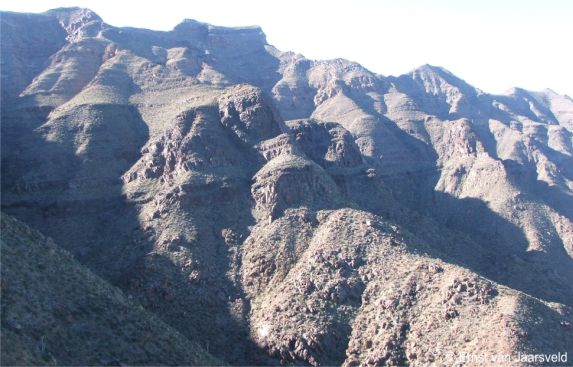
Fig. 4. The Hunsberg, southern Namibia, the habitat of Crassula sladenii and of so many unique succulents and other plants. It is a rugged mountain range which, in fact, forms part of the western escarpment mountains, and through which the Orange River cuts a deep gorge.
The vegetation consists of Western Gariep Lowland Desert of the Desert Biome as well as Succulent Karoo Biome (Mucina 2006). Associated cliff-dwellers recorded from Kuansip include Aloe pavelkae, Crassula macowaniana, Hartmanthus sp., Haworthiopsis tessellata and Tylecodon racemosus. The geology consists of dolomite and sandstone of the Kuibis and Schwarzrand Subgroups (Nama Group). The rock formation is rugged, rough, with many ledges, crevices and fissures, ideal for the establishment of plants. Plants are firmly rooted in crevices, sometimes solitary in small crevices or socially with other cliff-dwelling succulents. Temperatures are moderate to high in summer and can reach 40°C. Winters are cooler but frost is absent. The average daily maximum temperature is 27°C and the average daily minimum for the region is 13°C. Rainfall occurs mainly in winter, ranging from 75–200 mm per annum in the form of thunder showers or cyclonic winter rain.
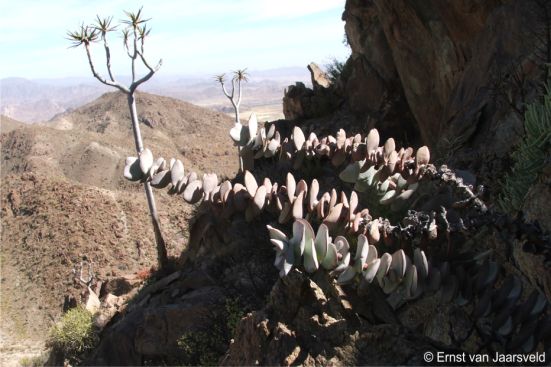
Fig. 5. An adult plant of Crassula sladenii growing on a rock face of the Hunsberg, southern Namibia, with Aloidendron dichotomum and the Orange River in the background.
Derivation of name and historical aspects
History
Crassula sladenii was named by the German botanist, Selmar Schönland (1860–1940) in 1912 in the Annals of the of the South African Museum from plants collected by Harold Pearson (1870–1916) on a collecting trip funded by the Percy Sladen Memorial Trust. Harold Pearson collected his plants at the Numees Mine in Helskloof, Richtersveld, Northern Cape. The plants commemorate William Percy Sladen, a British naturalist who died in 1900.
Crassula sladenii belongs to section Perfilatae in which 6 species belong. These include Crassula badspoortensis, C. fusca, C. macowaniana, C. perforata, C. sladenii, C. rupestris and C. brevifolia. Adrian Haworth, British succulent botanist, created this section in 1828 to accommodate those species with woody stems and leaves with obvolute vernation, a stalked inflorescence and small tubular flowers. Section Perfilatae are popular among succulent enthusiasts due to the ornamental appeal of their leaves. Of these species C. badspoortensis, C. sladenii and C. rupestris subsp. marnieriana are mostly obligatory cliff-dwellers. Crassula sladenii comes closest to C. badspoortensis and C. brevifolia, easily distinguished by its very fleshy, egg-shaped to ovate lanceolate leaves.
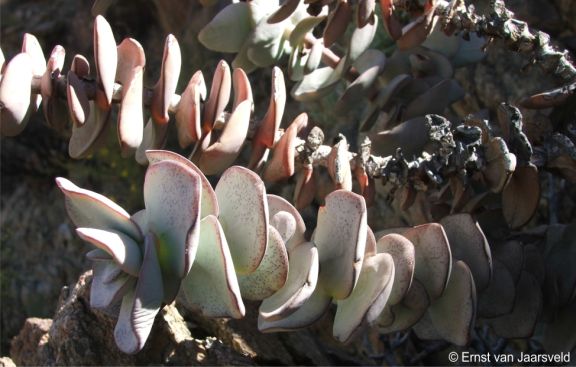
Fig. 6. Crassula sladenii growing on a dolomite cliff on the Hunsberg. Note the leafy stems, as well as the pale green leaf surface as a result of a powdery bloom.
Ecology
Ecology
Plants usually grow solitary as a cliff squatter with little-branched, pendent, leafy branches. The leafy branches store sufficient moisture enabling the plant so survive periods of drought. Branches bend downwards at the apices, becoming pendulous to subpendulous. This epinastic growth, becoming pendent, can be viewed as an adaptation to the cliff environment. The leaf orientation is spreading, closely packed and fused at the bases. Leaves are grey-green to glaucous, covered with a powdery bloom, becoming distinctly purplish reddish during dry periods, suggesting adaptation to the extreme xeric conditions of the cliff face. The reddish colour under dry conditions reduces penetration of light, another adaptation resulting from the extreme run-off in the sheer habitat.
The fruits (follicles) are dehiscent, with seeds spontaneously released and dispersed by wind. Seeds are very fine dust-like, ideal for establishment in crevices. Seeds are released in autumn and winter, just in time for the winter rains and thus maximising establishment.
Stems will root when coming in close contact with crevices, an efficient vegetative backup strategy for surviving the harsh conditions on the cliff face. A detached branch will root.
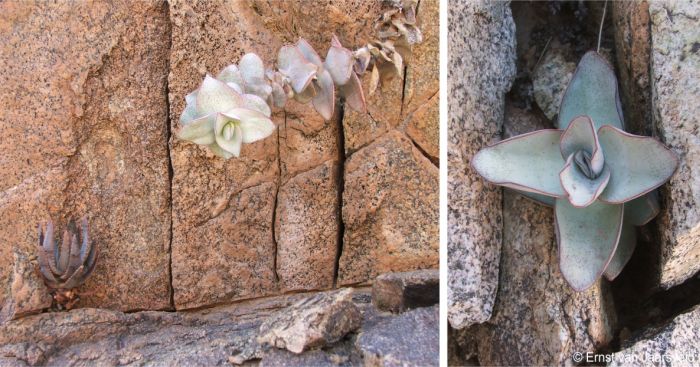
Fig. 7. left Crassula sladenii growing on a granite cliff with a young quiver tree (Aloidendron dichotomum), and right, a young plant of Crassula sladenii growing on a granite rock face of the Hunsberg, southern Namibia.
Uses
Use
It is not known whether the plants are used medicinally. Crassula sladenii is not well-known in cultivation but makes a beautiful potplant.
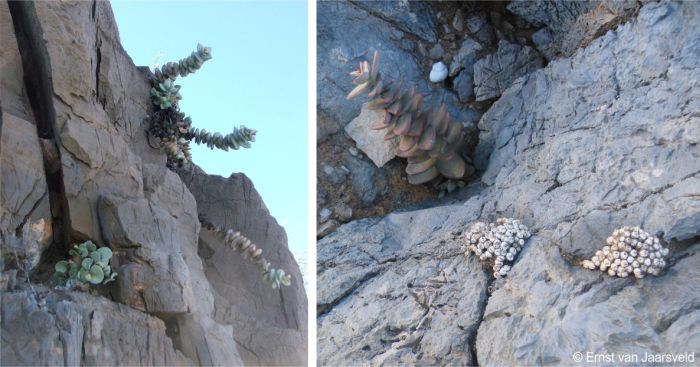
Fig. 8. left Crassula sladenii growing on a dolomite cliff on the Hunsberg, southern Namibia, and right, growing on the Kortdoringberg, Richtersveld, Northern Cape, South Africa.
Growing Crassula sladenii
Grow
Easily cultivated, it prefers dappled shade. Best for dry Succulent Karoo and Desert gardens, grown in rockeries, on embankments or as a pot plant. Outside its native habitat, it is best grown under controlled conditions in a greenhouse. When well grown it makes a beautiful pot plant. Provide sufficient light and ventilation, and well-drained soil low in organic content. Water sparingly. Drench the pot and allow the plant to dry out for some time before watering again. The stored moisture in their leaves and stems allows succulents to survive when no soil moisture is present.
Propagate from cuttings or seed. Take cuttings in spring or autumn. Plant cuttings of 8-12 cm length in a sandy soil. Seed is fine and can be sown in a sandy mixture in autumn. Cover with a very thin layer of gravel. Keep moist. Remove seedlings as soon they are large enough to handle.
The roots sometimes can be affected by mealybug, treat accordingly. Overwatering or poorly drained soil can cause fungal diseases and rotting.
References
- Christenhusz, M.J.M., Fay, M.F. & Chase, M.W. 2017. Plants of the World, an illustrated Encyclopedia of vascular plants. Kew Publishing, Royal Botanic Gardens, Kew.
- Clarke, H. & Charters, M. 2016. The illustrated dictionary of southern African plant names. Flora & Fauna Publications Trust, Jacana, Johannesburg.
- Eggli, U. (ed.) 2003. Illustrated handbook of succulent plants: Crassulaceae. Springer, Berlin.
- Linnaeus, C. 1753. Species plantarum. 1st edition. Salvius, Stockholm.
- Mucina, L. & Rutherford, M.C. (eds) 2006. The vegetation of South Africa, Lesotho and Swaziland. Strelitzia 19. South African National Biodiversity Institute, Pretoria.
- Raimondo, D., Von Staden, L., Foden, W., Victor, J.E., Helme, N.A., Turner, R.C., Kamundi, D.A. & Manyama, P.A. (eds) 2009. Red list of South African plants. Strelitzia 25. South African National Biodiversity Institute, Pretoria.
- Raimondo, D., Burgoyne, P.M., von Staden, L. & Van Wyk, P.C.V. 2015. Crassula sladenii Schönland. National Assessment: Red List of South African Plants. http://redlist.sanbi.org/species.php?species=3835-390.
- Rowley, G. 2003. Crassula: a growers guide. Cactus & Co. Vista, California.
- Snijman, D.A. (ed.). 2013. Plants of the Greater Cape Floristic Region 2: The Extra Cape Flora. Strelitzia 30. South African National Biodiversity Institute, Pretoria.
- Toelken, H.R. 1985. Crassulaceae. Flora of Southern Africa 14: 1–244.
- Van Jaarsveld, E.J. & Van Wyk, A.E. 2001. Crassula badspoortense, a new species from the Western Cape Province. Aloe 38:29–30.
- Van Jaarsveld, E.J. & Van Wyk, A.E. 1999. Five new cremnophilous taxa from semi-arid regions in South Africa. Aloe 36 (4): 71–74).
Credits
Ernst van Jaarsveld
Kirstenbosch National Botanical Garden (Retired)
Babylonstoren Farm
Extraordinary senior lecturer and researcher,
Department of Biodiversity and Conservation, University of the Western Cape
January 2024
Acknowledgements: the author thanks Jeanette Loedolff for preparing the illustration.
Plant Attributes:
Plant Type: Scrambler, Shrub, Succulent
SA Distribution: Northern Cape
Soil type: Sandy
Flowering season: Autumn
PH: Acid, Neutral
Flower colour: White
Aspect: Morning Sun (Semi Shade), Afternoon Sun (Semi Shade)
Gardening skill: Easy
Special Features:
Horticultural zones
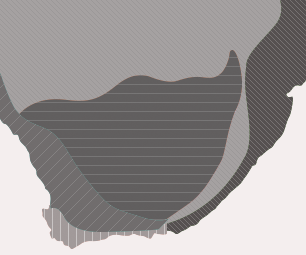







Rate this article
Article well written and informative
Rate this plant
Is this an interesting plant?
Login to add your Comment
Back to topNot registered yet? Click here to register.